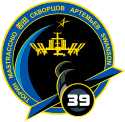Expedition 39
| Expedition 39 | |||
 | |||
| Uppdragsstatistik | |||
|---|---|---|---|
| Rymdstation: | ISS | ||
| Start: | 10 mars 2014[1] | ||
| Slut: | 13 maj 2014[1] | ||
| Antal besättningsmedlemmar: | 6 st | ||
| Rymdpromenad | |||
| Antal rymdpromenader: | 1st | ||
| Total tid: | 1 timme, 36 minuter | ||
| Transport | |||
| Uppskjutning: | med Sojuz TMA-11M, Sojuz TMA-12M | ||
| Uppskjutningsplats: | Kosmodromen i Bajkonur | ||
| Landning: | med Sojuz TMA-11M, Sojuz TMA-12M | ||
| Landningsplats: | Kazakstan | ||
| Kronologi | |||
| |||

Expedition 39 var den 39:e expeditionen till Internationella rymdstationen (ISS). Expeditionen började den 10 mars 2014 då delar av Expedition 38s besättning återvände till jorden med Sojuz TMA-10M.
Koichi Wakata, Richard A. Mastracchio och Michail Tiurin anlände till stationen med Sojuz TMA-12M den 27 mars 2014.
Expeditionen avslutades den 13 maj 2014 då Wakata, Mastracchio och Tiurin återvände till jorden med Sojuz TMA-11M.
Besättning
| Position | Första delen (10 - 27 mars 2014) | Andra delen (27 mars - 13 maj 2014) |
|---|---|---|
| Befälhavare | Hans fjärde rymdfärd | |
| Flygingenjör 1 | Hans fjärde rymdfärd | |
| Flygingenjör 2 | Hans tredje rymdfärd | |
| Flygingenjör 3 | Hans andra rymdfärd | |
| Flygingenjör 4 | Hans första rymdfärd | |
| Flygingenjör 5 | Hans tredje rymdfärd | |
Referenser
- ^ [a b] NASA's Space Station Expedition 39 Arkiverad 16 augusti 2019 hämtat från the Wayback Machine., läst 3 september 2016.
Externa länkar
| |||||||||||||||||||
Media som används på denna webbplats
Expedition 39 crew members take a break from training at NASA's Johnson Space Center to pose for a crew portrait. Pictured on the front row are Japan Aerospace Exploration Agency (JAXA) astronaut Koichi Wakata (right), commander; and NASA astronaut Steve Swanson, flight engineer. Pictured from the left (back row) are Russian cosmonauts Oleg Artemyev, Alexander Skvortsov, Mikhail Tyurin and NASA astronaut Rick Mastracchio, all flight engineers.
ISS Expedition 38 Patch
As the International Space Station (ISS) has become a stepping stone to future space exploration, the Expedition 38 mission patch design paints a visual roadmap of exploration beyond low Earth orbit, most prominently represented by the design's flowing Expedition 38 mission numbers that wrap around Earth, the moon and Mars. Just as the sun is a guiding light in the galaxy, the ISS illuminates the bottom of the design as it is a shining beacon of the advancement of science, knowledge, and technology carried out aboard the Space Station. To visually capture the idea of the ISS being a foundation for infinite discovery, the space station's iconic solar arrays span upwards, providing the number 38 and its exploration roadmap a symbolic pedestal to rest on. Finally, the overall use of red, white, and blue in the design acknowledges the flags of the countries of origin for Expedition 38's crew -- the United States, Russia, and Japan.
ISS Expedition 39 Patch
Increment 39 of the International Space Station Program marks the 15th year of operation since the start of the space laboratory assembly. Today, the U.S., Russia, Japan, Canada and the European Space Agency are partnering in the operation of the largest ever orbital outpost managed by humankind. The names of the six crew members are depicted in their native languages. For Expedition 39, the Soyuz spacecraft serves as transport vehicle for the crew members to and from the station. During this expedition, the ISS will serve as a platform for scientific research, Earth and astronomical observation, education, as well as a stage for the development of new technologies used for the exploration beyond low Earth orbit. The star above the complex signifies human space exploration towards new frontiers. The crew members added these words: "The crew of Expedition 39 is proud to serve the international community in furthering our scientific knowledge and in expanding human presence in space."
The Expedition 40 patch depicts the past, present, and future of human space exploration. The crew wrote the description that follows: The reliable and proven Soyuz, our ride to the International Space Station (ISS), is a part of the past, present, and future. The ISS is the culmination of an enormous effort by many countries partnering to produce a first-class orbiting laboratory, and its image represents the current state of space exploration. The ISS is immensely significant to us as our home away from home and our oasis in the sky. The commercial cargo vehicle is also part of the current human space exploration and is a link to the future. A blend of legacy and future technologies is being used to create the next spacecrafts which will carry humans from our planet to destinations beyond. The sun on Earth's horizon represents the new achievements and technologies that will come about due to our continued effort in space exploration.






